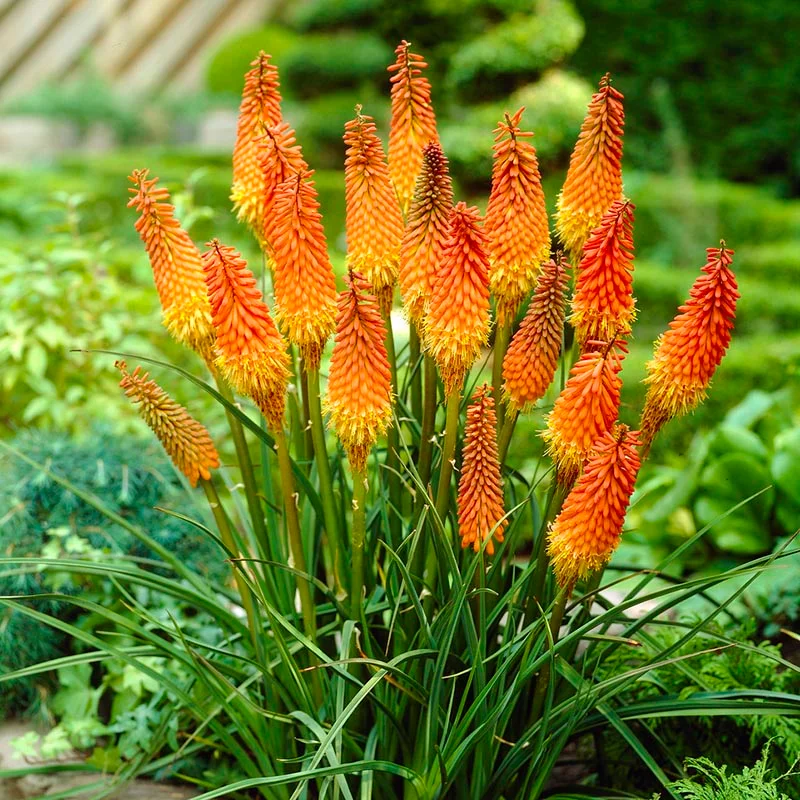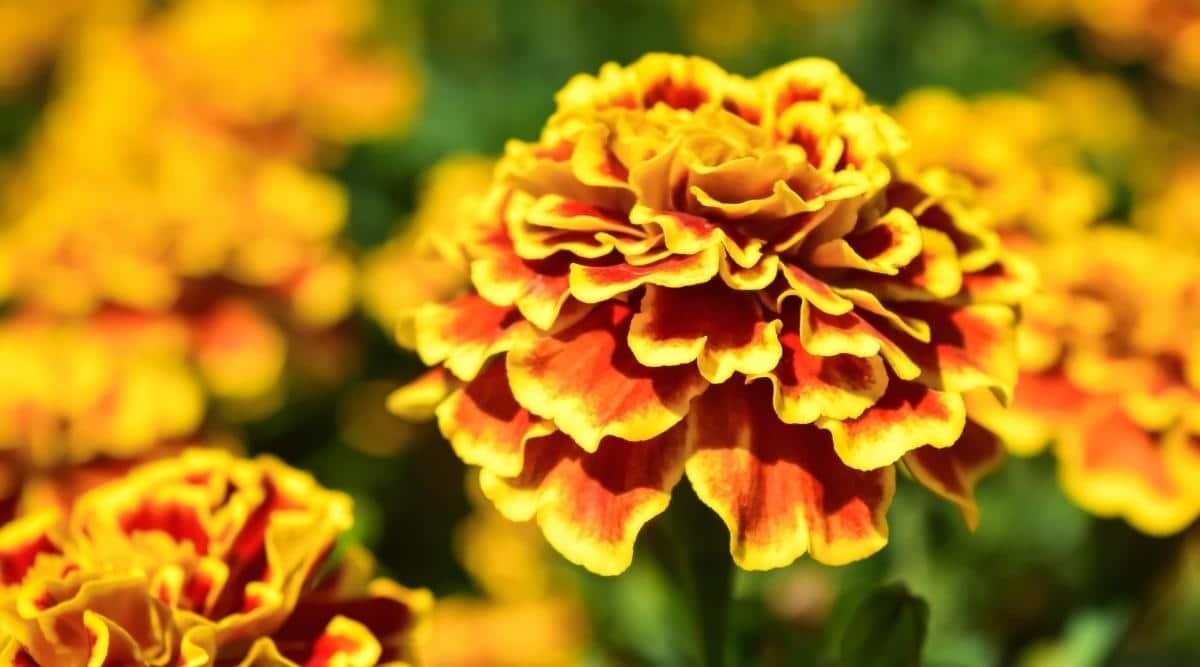Red Hot Poker Flower Facts, Uses, Cultivation, Botany, Historical Significance
 Red Hot Poker Flower Facts
Red Hot Poker Flower FactsRed Hot Poker Flower Facts | Description | Distribution and Habitat | Botany and evolution | Cultivation | Uses | Cultural | Interesting facts | frequently asked questions about Red Hot Poker
Looking to add a pop of fiery color to your garden? Look no further than the dazzling Flower Red Hot Poker! With its striking red and yellow spikes of flowers that resemble torches, this stunning plant is sure to be the centerpiece of any garden. Not only is it a showstopper, but it’s also low-maintenance and easy to grow, making it a great choice for both novice and experienced gardeners. So why settle for a boring garden when you can add a touch of heat with the Flower Red Hot Poker?
Taxonomy of Red Hot Poker
| Kingdom | Plantae |
|---|---|
| Clade | Angiosperms |
| Clade | Monocots |
| Order | Asparagales |
| Family | Asphodelaceae |
| Subfamily | Asphodeloideae |
| Genus | Kniphofia |
| Species | Kniphofia uvaria |
Morphology of Red Hot Poker
| Morphological Feature | Description |
|---|---|
| Height | 2-4 feet (0.6-1.2 meters) |
| Leaves | Long, narrow, strap-like, up to 3 feet (0.9 meters) in length |
| Flowers | Spike-like inflorescence, 24-48 inches (60-120 cm) in length |
| Flower color | Bright red or orange, with yellow tips |
| Blooming period | Mid-summer to early fall |
| Fruit | Dry capsule containing numerous small seeds |
| Root system | Fibrous |
| Growth habit | Clumping |
| Hardiness zone | 5-9 |
| Sun requirement | Full sun to partial shade |
| Soil requirement | Well-drained, fertile soil |

Description of Red Hot Poker
The Flower Red Hot Poker, also known as Kniphofia uvaria, is a stunning perennial herbaceous plant native to South Africa, Lesotho, and Swaziland. It belongs to the Asphodelaceae family and has an impressive height of up to 1.5 meters (5 feet). The plant has a basal rosette of long, narrow leaves with sharp tips, and alternate stem leaves.
During the summer and early fall, the Flower Red Hot Poker produces striking spike-like inflorescences with tubular-shaped flowers in shades of red, orange, and yellow. Each inflorescence can have up to 100 individual flowers, which can reach a height of 60-120 cm (24-48 in) and a width of 5-10 cm (2-4 in). The flowers are known for their unique shape and vibrant colors, resembling torches or poker flames, which adds a pop of fiery color to any garden.
The plant produces capsules that contain numerous seeds that are dispersed by wind or self-dispersal when the capsules dry and split open. The Flower Red Hot Poker is also known for its fibrous roots that allow it to withstand dry conditions and thrive in a variety of soil types.
In summary, the Flower Red Hot Poker is a showstopper in any garden with its stunning spike-like inflorescences and vibrant colors. Its low-maintenance nature and ability to thrive in different soil types make it an excellent choice for both novice and experienced gardeners.
Distribution and habitat of Red Hot Poker
The Flower Red Hot Poker, or Kniphofia uvaria, is native to southern Africa, specifically South Africa, Lesotho, and Swaziland. It is found in grasslands, rocky slopes, and marshy areas, and can grow in a variety of soil types, including sand, clay, and loam.
In its native range, the Flower Red Hot Poker is a common sight in the landscape and is often used as an ornamental plant in gardens and landscaping. However, it has also been naturalized in other parts of the world, including Europe, North America, and New Zealand, where it is often cultivated as a garden plant.
The Flower Red Hot Poker is adapted to dry conditions and can survive in areas with low rainfall. It has a deep root system that allows it to access water from deeper soil layers, and its leaves are adapted to reduce water loss through transpiration.
Overall, the Flower Red Hot Poker is a versatile plant that can thrive in a range of habitats and is widely cultivated as an ornamental plant due to its stunning appearance.
Botany and evolution of Red Hot Poker
The Flower Red Hot Poker, or Kniphofia uvaria, belongs to the Asphodelaceae family and is a monocot plant. It is a herbaceous perennial, meaning it dies back to the ground each year and regrows from the roots the following season.
The plant has a basal rosette of long, narrow leaves with sharp tips, and alternate stem leaves. The flowers are arranged in a dense spike-like inflorescence, with each flower having a tubular shape and six tepals. The flowers are pollinated by birds, bees, and butterflies.
The evolution of the genus Kniphofia is poorly understood, and there is still debate about its classification within the Asphodelaceae family. The genus is believed to have originated in southern Africa, and there are over 70 species of Kniphofia plants, which vary in their flower color, size, and shape.
One interesting adaptation of the Flower Red Hot Poker is its fibrous root system, which allows it to thrive in dry conditions by accessing water from deeper soil layers. The leaves are also adapted to reduce water loss through transpiration, which is important in areas with low rainfall.
Overall, the Flower Red Hot Poker is a fascinating plant with unique adaptations and a striking appearance that makes it a popular choice for gardeners and landscapers alike.
Cultivation of Red Hot Poker
The Flower Red Hot Poker, or Kniphofia uvaria, is a popular garden plant that is relatively easy to cultivate. It is adaptable to a range of soil types and can tolerate both wet and dry conditions, although it prefers well-drained soil.
Propagation of the Flower Red Hot Poker can be done by division of the clumps, which should be done in the spring or fall. It can also be propagated by seed, although this method can be more challenging due to the variable germination rates.
The Flower Red Hot Poker prefers full sun and should be planted in an area that receives at least 6 hours of sunlight per day. It can be grown in pots or in the ground, and it is important to keep the soil moist during the growing season.
Fertilizing the Flower Red Hot Poker is not necessary, but a well-balanced fertilizer can be applied in the spring to encourage growth and blooming. Deadheading the spent flowers can also encourage additional blooms.
In areas with cold winters, the Flower Red Hot Poker may die back to the ground and reemerge in the spring. In warmer climates, it may remain evergreen throughout the year.
Overall, the Flower Red Hot Poker is a low-maintenance plant that is a great choice for novice and experienced gardeners alike. Its striking appearance and adaptability make it a popular choice for garden beds, borders, and containers.
Uses of Red Hot Poker
The Flower Red Hot Poker, or Kniphofia uvaria, has several uses, both ornamental and medicinal.
Ornamentally, the Flower Red Hot Poker is a popular garden plant due to its striking appearance and adaptability to a range of growing conditions. It can be used in garden beds, borders, and containers to add a splash of color and texture to the landscape.
The Flower Red Hot Poker is also used in traditional medicine in its native range of southern Africa. The roots of the plant have been used for their antimicrobial, antitumor, and anti-inflammatory properties, and are often used to treat a range of ailments, including fever, diarrhea, and skin conditions.
In addition, the Flower Red Hot Poker is also used in the production of honey. The nectar of the flowers is high in sugar and is a favorite of bees and other pollinators. The resulting honey has a distinct flavor and is prized by honey enthusiasts.
Overall, the Flower Red Hot Poker is a versatile plant with several uses, both ornamental and medicinal. Its stunning appearance and unique adaptations make it a popular choice for gardeners, and its medicinal properties have been recognized for centuries in its native range.
Cultural and Historical Significance of Red Hot Poker
The Flower Red Hot Poker, or Kniphofia uvaria, has cultural and historical significance in its native range of southern Africa.
In Zulu culture, the Flower Red Hot Poker is known as “isiHlabelelo,” and its roots have been used for centuries for their medicinal properties. The plant is also used in traditional rituals and is believed to have protective and cleansing properties.
The Flower Red Hot Poker was first introduced to Europe in the late 17th century, and it quickly became a popular garden plant due to its striking appearance. It has since been introduced to other parts of the world, including North America and New Zealand, where it is also widely cultivated as an ornamental plant.
In addition to its ornamental uses, the Flower Red Hot Poker has also been used in the production of honey in its native range. The nectar of the flowers is high in sugar and is a favorite of bees and other pollinators, making it an important crop for honey production.
Overall, the Flower Red Hot Poker has a rich cultural and historical significance in its native range, and its striking appearance and unique adaptations have made it a popular plant in gardens and landscaping around the world.
Explanatory Notes for Red Hot Poker
Explanatory notes for the Flower Red Hot Poker, or Kniphofia uvaria, can provide additional information on the plant’s characteristics, growing requirements, and uses.
Some possible explanatory notes for the Flower Red Hot Poker could include:
- The Flower Red Hot Poker is a member of the Asphodelaceae family, which also includes plants such as aloes and agaves.
- The plant is native to southern Africa, where it grows in a range of habitats, from rocky outcrops to moist grasslands.
- The Flower Red Hot Poker typically grows to a height of 2-4 feet, with leaves that are strap-like and up to 3 feet long.
- The flowers of the plant are arranged in a dense, cylindrical spike that can reach up to 2 feet in length. The flowers are tubular and come in shades of red, orange, and yellow.
- The Flower Red Hot Poker is a hardy plant that can tolerate temperatures down to -20°F, making it suitable for growing in a range of climates.
- The plant prefers full sun but can also tolerate partial shade. It requires well-draining soil and should be watered regularly during the growing season.
- The Flower Red Hot Poker is a low-maintenance plant that is relatively disease-resistant. Deadheading spent flowers can encourage additional blooming.
- The roots of the plant have been used for centuries in traditional medicine in southern Africa, and the nectar of the flowers is also used in the production of honey.
- The Flower Red Hot Poker is a popular garden plant due to its striking appearance and adaptability to a range of growing conditions. It can be used in garden beds, borders, and containers to add a splash of color and texture to the landscape.
Interesting facts about Red Hot Poker
Here are 10 interesting facts about the Flower Red Hot Poker, or Kniphofia uvaria:
- The Flower Red Hot Poker is also known by several other common names, including Torch Lily, Tritoma, and Poker Plant.
- The plant is native to southern Africa, where it is found in countries such as South Africa, Lesotho, and Swaziland.
- The Flower Red Hot Poker is a member of the Asphodelaceae family, which includes other notable plants such as aloes and agaves.
- The flowers of the plant are pollinated by birds, such as sunbirds, which are attracted to the bright colors of the flowers.
- The nectar of the flowers is high in sugar and is a favorite of bees and other pollinators, making it an important crop for honey production.
- The Flower Red Hot Poker has been introduced to other parts of the world, including North America and New Zealand, where it is also widely cultivated as an ornamental plant.
- The plant is well adapted to a range of growing conditions and can thrive in poor soil, full sun, and even drought conditions.
- The roots of the plant have been used for centuries in traditional medicine in southern Africa, and are believed to have antimicrobial, antitumor, and anti-inflammatory properties.
- The Flower Red Hot Poker is a low-maintenance plant that is relatively disease-resistant and requires minimal pruning or fertilization.
- The Flower Red Hot Poker has been a popular garden plant for centuries, and has been featured in artwork, literature, and even postage stamps.
General queries or frequently asked questions about Red Hot Poker
What is the Flower Red Hot Poker?
The Flower Red Hot Poker, or Kniphofia uvaria, is a flowering plant native to southern Africa.
What are the characteristics of the Flower Red Hot Poker?
The Flower Red Hot Poker has long, strap-like leaves and cylindrical spikes of tubular flowers in shades of red, orange, and yellow.
What are the growing requirements for the Flower Red Hot Poker?
The Flower Red Hot Poker prefers full sun and well-draining soil, and can tolerate drought and low-nutrient conditions.
What are the uses of the Flower Red Hot Poker?
The Flower Red Hot Poker is primarily grown as an ornamental plant in gardens and landscapes, but has also been used in traditional medicine and honey production.
How do you care for a Flower Red Hot Poker plant?
The Flower Red Hot Poker requires regular watering during the growing season, deadheading spent flowers, and occasional fertilization.
What are some common pests and diseases that affect the Flower Red Hot Poker?
The Flower Red Hot Poker is relatively disease-resistant but may be susceptible to root rot and some leaf spot diseases. Common pests include spider mites and aphids.
Can you grow the Flower Red Hot Poker indoors?
While the Flower Red Hot Poker can be grown in containers, it typically requires full sun and may be difficult to grow indoors.
When is the best time to plant the Flower Red Hot Poker?
The best time to plant the Flower Red Hot Poker is in the spring, after the threat of frost has passed.
How long do the flowers of the Flower Red Hot Poker last?
The flowers of the Flower Red Hot Poker typically last for several weeks, and deadheading spent flowers can encourage additional blooming.
Is the Flower Red Hot Poker toxic to humans or pets?
The Flower Red Hot Poker is not considered toxic to humans or pets, but the leaves may cause skin irritation in some individuals.
Conclusion
In conclusion, the Flower Red Hot Poker, or Kniphofia uvaria, is a fascinating and versatile plant with many uses and interesting characteristics. It is native to southern Africa, but has been introduced to other parts of the world and is widely cultivated as an ornamental plant in gardens and landscapes. The Flower Red Hot Poker is well adapted to a range of growing conditions and is relatively low-maintenance, making it a popular choice for many gardeners. In addition to its aesthetic appeal, the plant has been used in traditional medicine and honey production, and has even been featured in artwork, literature, and postage stamps. With its bright, showy flowers and unique growth habit, the Flower Red Hot Poker is a beautiful and intriguing addition to any garden or landscape












